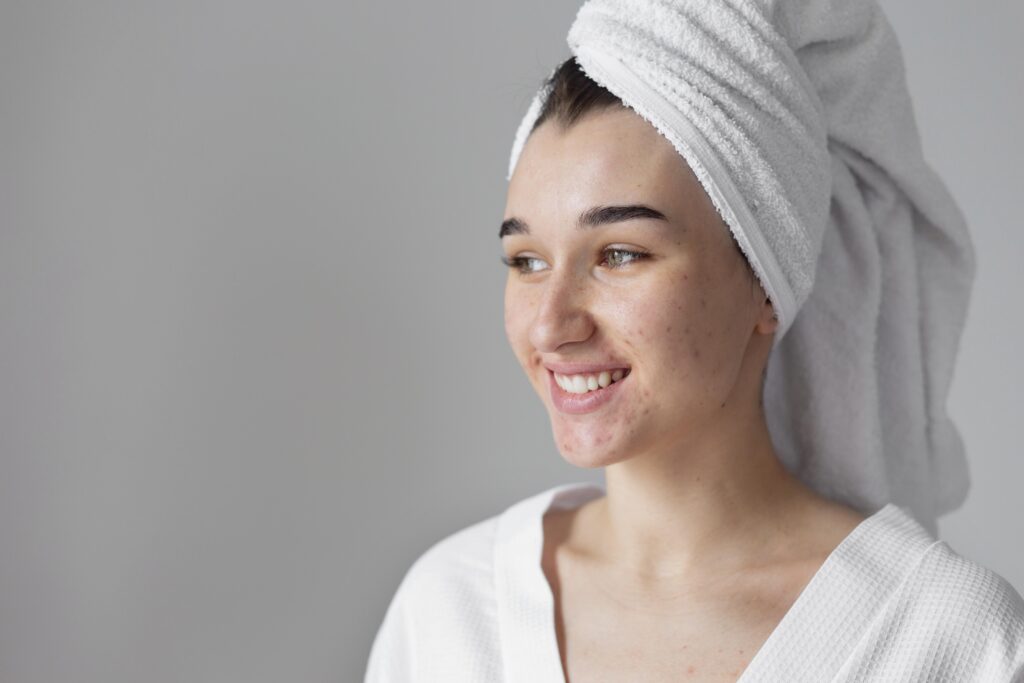
Being someone with dry skin and struggling with hyperpigmentation, you know the challenges that come with it. When you try to manage these two conditions, finding the right skincare routine can feel like navigating a labyrinth. But don’t worry. You are not alone in this. You can effectively manage and reduce hyperpigmentation while nourishing and hydrating dry skin with the proper skincare routine and products.
This ultimate guide will explore the best skincare routine for dry skin with hyperpigmentation. By the end of this article, you’ll be armed with the knowledge and products you need to achieve more even complexion and hydrated, radiant skin.
Understanding Dry Skin and Hyperpigmentation
Before diving into the best skincare routine possible, it’s crucial to understand both dry skin and hyperpigmentation.
Dry Skin (Xeroderma)
It is a skin type that doesn’t have enough moisture and oil to keep it feeling soft. The medical term for dry skin is ‘Xeroderma’, while ‘Xerosis’ is for severely dry skin. Dry skin can feel tight and rough, and even feel rough patches with flakiness or redness. Dry skin is often more prone to fine lines and wrinkles, and hence, a key factor in aging. So, it is essential to keep your skin well-hydrated.

Also Read:
Does Dry Skin Cause Wrinkles? Revealing The Truth!
Hyperpigmentation
Hyperpigmentation, on the other hand, is a common condition that makes some areas of the skin darker than others. It occurs as dark spots, patches, or uneven skin tone. Multiple factors, including sun exposure, hormonal changes, and skin injuries, can cause it. This condition occurs when the skin produces extra melanin in specific areas. Excess melanin creates spots or patches that look brown, black, gray, red, or pink. While these areas with pigments are not painful or itchy, they can make people self-conscious. The common types of hyperpigmentation include:

Both these conditions (dry skin and hyperpigmentation) can occur from various factors, including genetics, sun exposure, and certain skincare products.
Best Skincare Routine for Dry Skin With Hyperpigmentation
Now that we have the basic knowledge of Dry Skin and Hyperpigmentation, let’s dive into the step-by-step skincare routine that effectively addresses these beauty concerns.
Step 1: Gentle Cleansing
The foundation of any skincare routine is always a gentle yet effective cleanser. Opt for a sulfate-free, hydrating cleanser for dry skin prone to hyperpigmentation. A hydrating cleanser helps remove impurities from the skin. These cleansers cleanse without stripping the skin of its natural oils, which are essential for maintaining skin barrier integrity.

Pro Tip: Always avoid hot water while cleansing. It can further dry out your skin. Opt to use lukewarm water instead.
Step2: Exfoliation
Exfoliation is a term derived from the Latin word ‘exfoliare’, which means to be shed from a surface in scales or layers. In cosmetology, it removes the surface of skin cells and built-up dirt from the skin’s surface. Exfoliation is a crucial step in managing hyperpigmentation. It helps remove dead skin cells, allowing other skincare products to penetrate deeper. Go for exfoliants containing alpha hydroxy acids (AHAs) or beta hydroxy acids (BHAs). These can help fade dark spots and improve skin texture.

Pro Tip: Start with a lower concentration and gradually increase to prevent over-exfoliation. Always use sunscreen with suitable SPF (normally 30) as your skin is more susceptible to UV damage. Repeat it 2-3 times a week.
Step 3: Targeted Serums
Serums are considered the workhorses of your skincare routine. If you plan to address hyperpigmentation, opt for serums containing ingredients like vitamin C, niacinamide, and kojic acid. All these ingredients can help brighten your skin and reduce the appearance of dark spots over time. It also provides antioxidant protection against environmental damage.
Pro Tip: Layering your serums can enhance their effectiveness. Apply the thinnest serum first and the thickest one at last.
Step 4: Moisturize Your Skin
For dry skin, a good moisturizer is non-negotiable. Always look for a rich, hydrating moisture that contains hyaluronic acid, ceramides, or glycerin. These ingredients help lock in moisture. This step is crucial in the skincare routine to prevent further dryness and keep the skin plump throughout the day.

Pro Tip: Prefer a night cream with added ingredients like retinol or niacinamide for added benefits.
Step 5: Sunscreen (Morning Routine)
Remember, sunscreen in your skincare routine as it tends to be your best friend when it comes to managing hyperpigmentation. Harmful UV rays from the sun can worsen existing dark spots and lead to new ones. Opt for a broad-spectrum sunscreen with an SPF of at least 30. Apply it every morning, even on cloudy days. Also, look for moisturizing sunscreen formulations to keep your dry skin happy.

Pro Tip: Reapply sunscreen every two hours if you’re outdoors for extended periods.
Step 6: Targeted Treatments (As Per Needed)
Depending on the severity of your hyperpigmentation, you may incorporate targeted treatments such as:
Note: These products or treatments should be used under the guidance of a dermatologist, as they can be potent and may cause irritation if not used correctly.
Step 7: Hydration and Lifestyle
In addition to your daily skincare routine, staying hydrated by drinking plenty of water and maintaining a healthy lifestyle can significantly impact your skin’s health. Along with hydration, you can follow these lifestyle changes:

- Eating a balanced diet rich in antioxidants and omega-3 fatty acids
- Getting enough sleep
- Stress management
These lifestyle hacks can help reduce hyperpigmentation and maintain skin elasticity.
Skincare Routine for Evening
You can make the following changes to a skincare routine for the evening:
- Double Cleanse – Begin with an oil-based cleanser to break down makeup and sunscreen, followed by your morning hydrated cleanser.
- Targeted Treatments – For nighttime, use products with ingredients like niacinamide, licorice root extract, or alpha arbutin to target hyperpigmentation. These ingredients can be found in serums or spot treatments.
- Moisturize Again – Use a richer moisturizer in the evening. Opt products containing ceramides or peptides. These ingredients repair skin carriers and improve moisture retention.
- Overnight Mask – Once or twice a week, replace your evening moisturizer with an overnight mask. For best results, choose one specially formulated for dry skin and hyperpigmentation.
Final Thoughts
Achieving radiant, hydrated, and even-toned skin when you have dry skin with hyperpigmentation may require some patience and consistency. However, following this comprehensive skincare routine and using recommended products, may significantly improve your beauty. You may improve the appearance of hyperpigmentation while keeping your skin well-hydrated and healthy.
Remember that skincare is profoundly personal, and the individual results may vary. So, don’t hesitate to consult with a dermatologist to create a personalized skin care plan tailored to your specific needs. With the right products, dedication, and a specific routine, you can confidently brace your natural beauty and achieve the glowing skin you’ve always desired. So, let’s move towards glowing, healthy skin!
FAQ: Best Skincare Routine for Dry Skin with Hyperpigmentation
Q.1: What causes dry skin and hyperpigmentation?
Dry skin can be caused by various factors including genetics, environmental elements (like cold, dry weather), over-washing, or using harsh skincare products. Hyperpigmentation, on the other hand, may result from sun exposure, hormonal changes, aging, skin injuries, or inflammation. Both conditions can coexist, particularly if the skin’s protective barrier is compromised, leading to moisture loss and increased sensitivity to sun damage.
Q.2: How often should I cleanse my skin if I have dry skin with hyperpigmentation?
Cleanse your skin twice a day—morning and night. Use a gentle, hydrating cleanser that doesn’t strip your skin of its natural oils. Avoid hot water as it can further dry out the skin, and opt for lukewarm water instead.
Q.3: What type of moisturizer is best for dry skin with hyperpigmentation?
Look for moisturizers that are rich in emollients and humectants like hyaluronic acid, glycerin, and ceramides. These ingredients help lock in moisture and repair the skin’s barrier. For hyperpigmentation, choose products with niacinamide or vitamin C, as they can brighten the skin and even out skin tone.
Q.4: Is sunscreen necessary even if I spend most of the day indoors?
Yes, sunscreen is crucial for protecting your skin from UV rays that can exacerbate dryness and hyperpigmentation. Use a broad-spectrum SPF 30 or higher every day, even if you’re indoors, as UV rays can penetrate through windows.
Q.5: What ingredients should I look for in products to address hyperpigmentation?
Ingredients such as vitamin C, niacinamide, kojic acid, arbutin, and licorice root extract can help lighten hyperpigmentation. Retinoids can also be effective, but they may be irritating for dry skin, so start with a low concentration and use them sparingly.
Q.6: How can I exfoliate my dry, hyperpigmented skin without causing irritation?
Opt for chemical exfoliants like lactic acid or mandelic acid, which are milder than physical exfoliants. They help remove dead skin cells, improve moisture retention, and fade hyperpigmentation. Limit exfoliation to once or twice a week to prevent over-exfoliation, which can lead to more dryness and irritation.
Q.7: Can I use retinoids if I have dry skin with hyperpigmentation?
Yes, but with caution. Start with a low-strength retinoid and use it once or twice a week to build your skin’s tolerance. Apply a moisturizer beforehand to reduce irritation. Monitor your skin’s response and adjust usage accordingly.
Q.8: Are there any professional treatments suitable for dry skin with hyperpigmentation?
Yes, professional treatments like chemical peels (with lactic or mandelic acid) and gentle laser treatments can be effective. However, they should be performed by a certified dermatologist, especially for sensitive or dry skin types, to avoid adverse effects.
Q.9: How long does it take to see results from a skincare routine aimed at dry skin with hyperpigmentation?
It can take several weeks to see noticeable improvements. Consistency is key. It’s important to maintain your skincare routine, protect your skin from the sun, and give the products time to work.
Q.10: Can changes in diet or lifestyle help improve dry skin and hyperpigmentation?
Yes, a well-balanced diet rich in antioxidants, healthy fats, and vitamins can support skin health. Stay hydrated, avoid smoking, limit alcohol consumption, and manage stress levels, as these factors can impact your skin’s condition. Additionally, try to minimize direct sun exposure, especially during peak hours, to prevent further hyperpigmentation and dryness.

